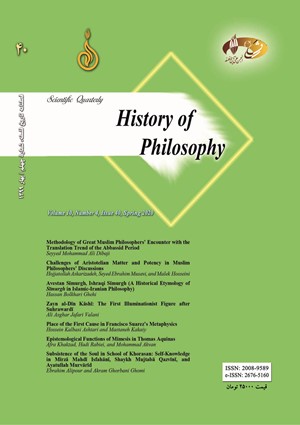-
-
List of Articles
-
Open Access Article
1 - Challenges of Aristotelian Matter and Potency in Muslim Philosophers’ Discussions
Hojjatullah Askarizadeh Seyyed Ebrahim Musavi Malek Hosseini -
Open Access Article
2 - Place of the First Cause in Francisco Suarez’s Metaphysics
Hossein Kalbasi Ashtari -
Open Access Article
3 - Methodology of Great Muslim Philosophers’ Encounter with the Translation Trend of the Abbassid Period
Seyyed Mohammadali Dibaji -
Open Access Article
4 - Epistemological Functions of Mimesis in Thomas Aquinas
Afra Khakzad Hadi Rabiei Mohammad Akvan -
Open Access Article
5 - Avestan Sīmurgh, Ishraqi Sīmurgh (A Historical Etymology of Sīmurgh in Islamic-Iranian Philosophy)
Hasan Bolkhari Qehi -
Open Access Article
6 - Editor's Note
Hossein Kalbasi Ashtari -
Open Access Article
7 - Zayn al-Dīn Kāshī: The First Illuminationist Figure after Suhrawardī
Aliasgar Jafary Valani -
Open Access Article
8 - Subsistence of the Soul in School of Khorasan: Self-Knowledge in Mīrzā Mahdī Isfahānī, Shaykh Mujtabā Qazvīnī, and Ayatullah Murvārīd
Ibrahim Alipour Ghorbani Ghomi
-
The rights to this website are owned by the Raimag Press Management System.
Copyright © 2017-2025







